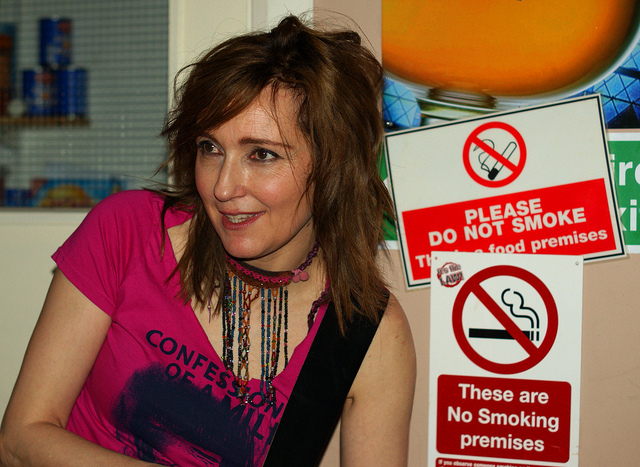Between 1976 and 1979, the British punk scene produced some very good albums (Never Mind the Bollocks; London Calling; Damned, Damned, Damned) and a couple of real brilliancies (The Pop Group’s Y, Gang of Four’s Entertainment.) But for sheer transgression, there is nothing to top Cut, the first album by The Slits. The record itself was so stylistically removed from the run of late ‘70s punk releases that it’s hard to come up with an appropriate reference point.
Central to The Slits’ anarchic program was their guitarist, Viv Albertine, whose self-developed guitar style took cues from rock, reggae, and funk without falling definitively within any of these stylistic milieus. Her recently published autobiography, Clothes, Clothes, Clothes, Music, Music, Music, Boys, Boys, Boys constitutes perhaps the most interesting of the dozens of memoirs written by figures in that scene. But Albertine’s book is more than simply another exercise in a rocker trying to relive (and/or make a buck off of) an “illustrious” past. It is an intensely honest and beautifully written account of a woman’s project of self-discovery and self-creation in a culture and a society built on making women toe the line.
Born in Australia in 1954 to a French father and a Swiss mother, Albertine’s family relocated to Muswell Hill, in London, when she was four, and she grew up in the years of scarcity in a Great Britain mostly left behind by the postwar boom. As the title of the book suggests, Albertine’s youth was shaped by concerns common to many adolescent girls, with the exception perhaps that the middle term was the one closest to her heart. From the start, Albertine showed an iconoclastic streak, and her story is atypical in that her trip through primary education did not lead to marriage, as it would have for most of her contemporaries even in the heady days of the late 1960s. Albertine pursued an interest in art, and it was in art school that she, as so many other figures who would come to prominence in the early punk scene, made the connections that would take her far outside the mainstream.
Working as a barmaid at Dingwall’s, Albertine had already become immersed in the London music scene, when she made the acquaintance of future Clash guitarist Mick Jones. She began an on-again off-again relationship with him that would profoundly affect her life for the next decade. There too she met Rory Johnston, an associate of Malcolm McClaren. This second acquaintance would prove crucial too, as it was Johnston who suggested that Albertine accompany him to the Chelsea College of Art in early December 1975 to see McClaren’s up and coming band. Seeing The Sex Pistols was a transformative experience for many.
Joe Strummer, who would first see them four months later when they opened for The 101ers at the Nashville would later tell Don Letts, “Five seconds into their first song I just knew we were yesterday’s papers. I mean, we were over.” Albertine had a similar reaction. The Pistols had an anarchic quality, but that was nothing new for Albertine, who’d already seen the likes of the Pink Fairies and the Pretty Things. What was new was Johnny Rotten, not a preening prima donna like Marc Bolan or David Bowie, “just a bloke from Finsbury Park, London, England, who’s pissed off.” In Rotten, Albertine saw a model of what she wanted to be, an expression of an experience that was hers:
“All the things I’m so embarrassed about, John’s made into virtues. He’s unapologetic about who he is and where he comes from. Proud of it even. He’s not taking the world’s lack of interest as confirmation that he’s wrong and worthless. I look up at him twisting and yowling and realise it’s everyone else who’s wrong, not him. How did he make that mental leap from musically untrained, state-school-educated, council-estate boy, to standing on stage in front of a band? I think he’s brave. A revolutionary. He’s sending a very powerful message, the most powerful message that anyone can ever transmit. Be yourself.”

Albertine found in this experience a moment of liberation. But where others in the scene would only superficially understand the punk ethos, using it simply to recreate rock culture in another key, Albertine went deeper. She soon bought a guitar (atypically supported in this by Mick Jones in one of his more lucid moments) and set herself on a path of creating art that would be an expression of herself rather than catering to the expectations of others. After months of scratching and bashing, during which her neighbors begged her to give it the guitar, Albertine joined The Slits (replacing original guitarist Kate Korus) and began the process of leaving her mark on punk in earnest.
The Slits were perhaps the most remarkable group to emerge from the early punk scene. So much of the other music that arose in the time could be directly traced to its antecedents, particularly in London pub rock. This was, in the first instance, a matter of personal and institutional connections. Clash front man Joe Strummer had been an up and coming face in that scene as the singer in The 101ers. The Sex Pistols were promoted (and accoutered) by Malcolm McClaren, whose Let It Rock boutique sold clothes for the Teddy Boys who made up a large proportion of the audience. The Damned’s seminal New Rose single was produced by Stiff Records in-house producer Nick Lowe, formerly the prominent pub rock band Brinsley Schwarz. But at an even more basic level, both scenes made direct stylistic reference to the American rock and roll culture of the 1950s.
The Slits, by contrast, signally lacked this reference point. As with The Pop Group and Gang of Four, there were fragments and traces of other musical styles present (principally Jamaican reggae and dub) but they were repurposed and reconfigured in ways that made them barely recognizable and fundamentally new. This was due in no small part to Albertine’s influence. Over and above their musical dimension, the very existence of a punk band composed only of women was a moment of serious transgression in and of itself.
It seems strange now, given how publicly prominent and neutered underground music has become, but even within the convention-smashing realm of the early punk scene The Slits were an alarming presence. Opening for The Clash on the White Riot Tour, they were banned even from hotels that agreed to put up the other bands. Even The Clash’s bus driver refused to transport them until the disturbingly ebullient Ari Up was shut up in the bus’s lavatory. She and her mates were not the only or the earliest female figures in the punk scene. Siouxsie Sioux, Gaye Advert, and Poly Styrene were all active earlier. But a band in which women were clearly the driving and defining force constituted the most powerful moment of radicalism that the British punk scene ever produced.
Collectively and individually, The Slits modelled a new kind of womanhood. Their songs dealt with themes relevant to young, lower middle class women, from relationships (Ping Pong Affair) to the media landscape (FM) to commodity culture (Shoplifting). At a personal level they formed a unit, an expression of female solidarity like, but also fundamentally unlike, that created among their male colleagues. When a smack-addled Keith Levine (or one of his smack-addled friends) steals drummer Palmolive’s purse, Albertine engineers its return by threatening to smash Levine’s kneecaps with a hammer. From their willingness to urinate in public (a feat usually reserved for males) to the cover photo from their first album Cut, featuring the band topless and covered in mud, The Slits evinced a determination to live life on their own terms and made it their business to transgress the restrictive gender norms of 1970s British society. In the last four-plus years of the band’s existence, Albertine and her mates lived the punk ethos in a ways that were much more profound than most other denizens of the scene.
While the first half of Clothes, Clothes, Music, Music, Music, Boys, Boys, Boys centers mostly on Albertine’s way in and out of The Slits, the second deals with her life afterward. When the band broke up in 1979, Albertine (who had subverted so many of the other tropes of rock and roll) found herself with a bad case of post band syndrome. Much of the latter portion of the book is taken up with the story of Albertine’s reintegration into the life of normal people: marriage, children, battling cancer, and learning to live the life of a suburban housewife. This too is instructive. Although the powerful impulse toward self-direction and self-creation never leaves, it is for a long time submerged. It takes two decades and the breakdown of her marriage for Albertine to discover the creative force of her personality and to recreate herself as an artist, but the arc of the book is one that shows that the things that drove her to prominence in the late 1970s had only lain latent in her settled life.
Albertine’s book is an entertaining read, but it is also valuable. She provides a narrative of a central figure who wasn’t one of the boys and who thus had to negotiate the gender politics and the specifics of her situation in ways much different than her male contemporaries. Albertine’s narrative is searingly honest, never shying away from painful truths. From her struggles against preconceptions of women’s role in the music scene to the ever-present threat of sexual violence, Albertine experienced the days of the British punk scene as at once more liberating and more threatening than it was for Johnny Rotten or Mick Jones.
In her post-punk life, Albertine struggled with the need to integrate the more anarchic dimensions of her personality not only with the expectations placed on women in mass society, but also with her own one, in which her forays into the world of underground music was only one moment in a longer story. It would be comforting to look at this as a parable of success, of Albertine’s life as opening up a space in which young women could create their own counter-hegemonic identities. But although punk in general and The Slits in particular had some success in this direction, it remains a struggle that each new generation of young women must wage on their own account. Still, Albertine’s story is a model, in fact a quite compelling one, of what can be achieved through the determination to live a life less ordinary.
Photographs courtesy of Phil King and Blast First Petite. All rights reserved.





